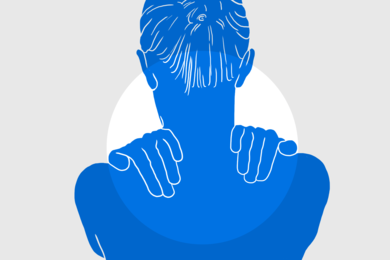Knowledge
Complex Regional Pain Syndrome (CRPS)

Introduction
Complex regional pain syndrome (CRPS) is an insufficiently understood condition. Affected people suffer from constant and often severe pain.
In most patients affected by CRPS, the problem is triggered by an injury. Typically, the pain is uncommonly severe and lasts longer than expected. Characteristically, only one limb (e.g., a hand) is affected. Rarely, the CRPS symptoms can also spread to other parts of the body.
A pain syndrome with many names
The first descriptions of CRPS were made at the end of the 19th century. Over time, various synonymous names have been used:
- Sudeck's disease
- Reflex dystrophy
- Algodystrophy
- Sympathetic reflex dystrophy
These terms have progressively been replaced by the internationally standardized term Complex Regional Pain Syndrome (CRPS).
Symptoms
Leading symptom: pain
The leading symptom of CRPS is pain. Affected patients often describe a combination of burning, stabbing and tingling pain.
Hypersensitivity
The skin of the affected limb can be overly sensitive. Light touches that are normally not painful, or changes in the temperature of the environment, can cause intense pain.
The following medical terms are important in this context:
- Hyperalgesia - Local external pressure, or a temperature effect that is normally not perceived as painful, clearly triggers pain.
- Allodynia - A normally non-painful touch (e.g. brushing the skin) triggers an unpleasant pain reaction.
- Sudden swellings, surprising changes in temperature.
Affected areas of the body may swell repeatedly. Affected joints are often stiff and mobility is limited. The skin may appear overheated, red and dry, but at a later stage it may also be just as cold, bluish and sweaty.
Altered hair and nail growth
There may be unusually slow or rapid hair and nail growth on limbs affected by CRPS.
Strange sensations
Strange sensations may occur in the limb affected by CRPS. It may feel like it does not belong to the body. Compared to the healthy opposite side, an affected limb may feel smaller or even larger.
Stress can make CRPS worse
Stress can cause a temporary increase in CRPS symptoms. These "flare-ups" worsen the pain situation and can last for days to weeks before improving again.
Causes
CRPS usually develops as a result of an injury. Typically, the symptoms appear within weeks of the injury. Injuries associated with CRPS can include broken bones, cuts, surgery, burns or simply a sprain.
The exact causes or mechanisms of CRPS are unknown. Due to the complex nature of the symptoms, it seems unlikely that this condition has a single, simple cause.
One of the main theories is based on the assumption that CRPS is the result of an abnormal, extended response of the body to an injury. It is thought that different systems of the body may malfunction and together contribute to CRPS:
- Brain and spinal cord
- Peripheral nerves (= nerves outside the brain and spinal cord)
- Immune system
- Blood vessels (arteries and veins)
Diagnosis
The diagnosis of CRPS is difficult. There is no suitable test that enables a definitive diagnosis. CRPS is usually diagnosed by excluding other diseases with similar symptoms.
If a chronic pain problem in the area of a limb cannot be adequately explained through medical examination, specific blood tests and radiological methods (e.g. MRI, X-ray, scintigraphy), the presence of CRPS is plausible.
The diagnosis is ultimately made according to the criteria of the IASP (International Association for the Study of Pain), which were drawn up in Budapest in 2003 and are therefore also called the "Budapest criteria".
Therapeutic options
In order to avoid further chronification as much as possible and to support a cure, the treatment of CRPS should be started as soon as possible.
The treatment of CRPS almost invariably involves a combination of different therapeutic measures. The therapeutic goals should not only be aimed at reducing the pain problem, but also at improving or maintaining the function of the affected limb (e.g. foot: walking, hand: grasping).
A suitable therapy for CRPS must be individually adapted to the affected patient. As a rule, non-drug, drug and, if necessary, interventional measures are combined.
- Self-management
- Being active and independent despite CRPS
- Preventing stressful situations that worsen CRPS
- Training in dealing with pain peaks
- Psychological support
- Psychotherapy if necessary
- Physiotherapy
- Basic pain medication
- NSAIDs (e.g. ibuprofen), paracetamol, metamizole
- Antineuropathic medications
- Tricyclic antidepressants
- SSNRI antidepressants
- Antiepileptic drugs
- Treatment with opiates
- For severe uncontrolled pain
- Only under close medical supervision
- Local / topical medications
- Local anaesthetics (e.g. lidocaine gel)
- Amitriptyline - Ketamine - Ointment
- DMSO ointment
- Serial infusion treatments
- Serial infusion of the NMDA receptor antagonist ketamine
- Interventional options
- Repetitive blocks of the sympathetic nervous system (hand: Ggl. stellatum, foot: border cord)
- Neuromodulation
- Spinal cord stimulation (SCS)
Prognosis
It is estimated that about 85% of patients affected by CRPS experience a noticeable improvement in their symptoms within two years.
References
www.rheuma-schweiz.ch: Schwerpunkt Komplexes Regionales Schmerzsyndrom




















